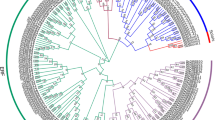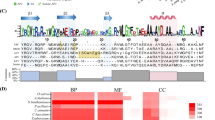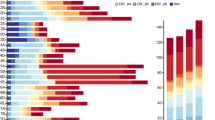Abstract
APETALA2/Ethylene-Responsive transcription factors (AP2/ERF), with their multifunctional roles in plant development, hormone signaling and stress tolerance, are important candidates for engineering crop plants. Here, we report identification and analysis of gene structure, phylogenetic distribution, expression, chromosomal localization and cis-acting promoter analysis of AP2/ERF genes in the C4 crop plant sorghum. We identified 158 ERF genes in sorghum with 52 of them encoding dehydration-responsive binding elements (DREB) while 106 code for ERF subfamily proteins. Phylogenetic analysis organized sorghum ERF proteins into 11 distinct groups exhibiting clade-specific expansion. About 68% ERF genes have paralogs indicating gene duplications as major cause of expansion of ERF family in sorghum. Analysis of spatiotemporal expression patterns using publicly available data revealed their tissue/genotype-preferential accumulation. In addition, 40 ERF genes exhibited differential accumulation in response to heat and/or drought stress. About 25% of the segmental gene pairs and eleven tandem duplicated genes exhibited high correlation (> 0.7) in their expression patterns indicating genetic redundancy. Comparative phylogenomic analysis of sorghum ERFs with 74 genetically characterized ERF genes from other plant species provided significant clues to sorghum ERF functions. Overall data generated here provides an overview of evolutionary relationship among ERF gene family members in sorghum and with respect to previously characterized ERF genes from other plant species. This information will be instrumental in initiating functional genomic studies of ERF candidates in sorghum.







Similar content being viewed by others
References
Aharoni A, Dixit S, Jetter R, Thoenes E, van Arkel G, Pereira A (2004) The SHINE clade of AP2 domain transcription factors activates wax biosynthesis, alters cuticle properties, and confers drought tolerance when overexpressed in Arabidopsis. Plant Cell 16(9):2463–2480. https://doi.org/10.1105/tpc.104.022897
Ahmad Dar R, Ahmad Dar E, Kaur A, Gupta Phutela U (2018) Sweet sorghum-a promising alternative feedstock for biofuel production. Renew Sustain Energy Rev 82:4070–4090. https://doi.org/10.1016/j.rser.2017.10.066
Arsovski AA, Pradinuk J, Guo XQ, Wang S, Adams KL (2015) Evolution of cis-regulatory elements and regulatory networks in duplicated genes of arabidopsis. Plant Physiol 169(4):2982–2991. https://doi.org/10.1104/pp.15.00717
Banno H, Ikeda Y, Niu QW, Chua NH (2001) Overexpression of arabidopsis ESR1 induces initiation of shoot regeneration. Plant Cell 13(12):2609–2618. https://doi.org/10.1105/tpc.010234
Bihani P, Char B, Bhargava S (2011) Transgenic expression of sorghum DREB2 in rice improves tolerance and yield under water limitation. J Agri Sci 149:95–101
Broun P, Poindexter P, Osborne E, Jiang CZ, Riechmann JL (2004) WIN1, a transcriptional activator of epidermal wax accumulation in Arabidopsis. Proc Natl Acad Sci USA 101(13):4706–4711. https://doi.org/10.1073/pnas.0305574101
Cao Y, Song F, Goodman RM, Zheng Z (2006) Molecular characterization of four rice genes encoding ethylene-responsive transcriptional factors and their expressions in response to biotic and abiotic stress. J Plant Physiol 163 (11):1167-1178. https://doi.org/10.1016/j.jplph.2005.11.004
Century K, Reuber TL, Ratcliffe OJ (2008) Regulating the regulators: the future prospects for transcription-factor-based agricultural biotechnology products. Plant Physiol 147(1):20–29. https://doi.org/10.1104/pp.108.117887
Chen H, Hwang JE, Lim CJ, Kim DY, Lee SY, Lim CO (2010) Arabidopsis DREB2C functions as a transcriptional activator of HsfA3 during the heat stress response. Biochem Bioph Res Co 401(2):238–244. https://doi.org/10.1016/j.bbrc.2010.09.038
Davidson RM, Gowda M, Moghe G, Lin H, Vaillancourt B, Shiu SH, Jiang N, Robin Buell C (2012) Comparative transcriptomics of three Poaceae species reveals patterns of gene expression evolution. Plant J 71(3):492–502. https://doi.org/10.1111/j.1365-313X.2012.05005.x
Dey S, Corina Vlot A (2015) Ethylene responsive factors in the orchestration of stress responses in monocotyledonous plants. Front Plant Sci 6:640. https://doi.org/10.3389/fpls.2015.00640
Dubouzet JG, Sakuma Y, Ito Y, Kasuga M, Dubouzet EG, Miura S, Seki M, Shinozaki K, Yamaguchi-Shinozaki K (2003) OsDREB genes in rice, Oryza sativa L., encode transcription activators that function in drought-, high-salt- and cold-responsive gene expression. Plant J 33(4):751–763
Finn RD, Clements J, Eddy SR (2011) HMMER web server: interactive sequence similarity searching. Nucleic Acids Res 39 (Web Server issue)(8):W29–W37. https://doi.org/10.1093/nar/gkr367
Gibbs DJ, Lee SC, Isa NM, Gramuglia S, Fukao T, Bassel GW, Correia CS, Corbineau F, Theodoulou FL, Bailey-Serres J, Holdsworth MJ (2011) Homeostatic response to hypoxia is regulated by the N-end rule pathway in plants. Nature 479(7373):415–418. https://doi.org/10.1038/nature10534
Gu C, Guo ZH, Hao PP, Wang GM, Jin ZM, Zhang SL (2017) Multiple regulatory roles of AP2/ERF transcription factor in angiosperm. Botan Stud. https://doi.org/10.1186/s40529-016-0159-1
Gupta S, JA S, TL B, Noble WS (2007) Quantifying similarity between motifs. Genome Biol 8:R24. https://doi.org/10.1186/gb-2007-8-2-r24
Hao D, Ohme-Takagi M, Sarai A (1998) Unique mode of GCC box recognition by the DNA-binding domain of ethylene-responsive element-binding factor (ERF domain) in plant. J Biol Chem 273(41):26857–26861
Hattori Y, Nagai K, Furukawa S, Song XJ, Kawano R, Sakakibara H, Wu J, Matsumoto T, Yoshimura A, Kitano H, Matsuoka M, Mori H, Ashikari M (2009) The ethylene response factors SNORKEL1 and SNORKEL2 allow rice to adapt to deep water. Nature 460(7258):1026–1030. https://doi.org/10.1038/nature08258
Heyn P, Kalinka AT, Tomancak P, Neugebauer KM (2015) Introns and gene expression: cellular constraints, transcriptional regulation, and evolutionary consequences. BioEssays 37(2):148–154. https://doi.org/10.1002/bies.201400138
Hu B, Jin J, Guo AY, Zhang H, Luo J, Gao G (2015) GSDS 2.0 an upgraded gene feature visualization server. Bioinformatics 31(8):1296–1297. https://doi.org/10.1093/bioinformatics/btu817
Jeffares DC, Penkett CJ, Bahler J (2008) Rapidly regulated genes are intron poor. Trends Genet 24(8):375–378. https://doi.org/10.1016/j.tig.2008.05.006
Jisha V, Dampanaboina L, Vadassery J, Mithofer A, Kappara S, Ramanan R (2015) Overexpression of an AP2/ERF type transcription factor OsEREBP1 confers biotic and abiotic stress tolerance in rice. PLoS ONE 10(6):e0127831. https://doi.org/10.1371/journal.pone.0127831
Johnson SM, Lim FL, Finkler A, Fromm H, Slabas AR, Knight MR (2014) Transcriptomic analysis of Sorghum bicolor responding to combined heat and drought stress. BMC Genom 15:456. https://doi.org/10.1186/1471-2164-15-456
Jung H, Chung PJ, Park SH, Redillas MCFR, Kim YS, Suh JW, Kim JK (2017) Overexpression of OsERF48 causes regulation of OsCML16, a calmodulin-like protein gene that enhances root growth and drought tolerance. Plant Biotechnol J 15(10):1295–1308. https://doi.org/10.1111/pbi.12716
Jung KH, Cao P, Sharma R, Jain R, Ronald PC (2015) Phylogenomics databases for facilitating functional genomics in rice. Rice 8(1):60. https://doi.org/10.1186/s12284-015-0060-7
Kasuga M, Miura S, Shinozaki K, Yamaguchi-Shinozaki K (2004) A combination of the Arabidopsis DREB1A gene and stress-inducible rd29A promoter improved drought- and low-temperature stress tolerance in tobacco by gene transfer. Plant Cell Physiol 45(3):346–350. https://doi.org/10.1093/pcp/pch037
Katoh K, Standley DM (2013) MAFFT multiple sequence alignment software version 7: improvements in performance and usability. Mol Biol Evol 30(4):772–780. https://doi.org/10.1093/molbev/mst010
Kaufmann K, Airoldi CA (2018) Master regulatory transcription factors in plant development: a blooming perspective. Methods Mol Biol 1830:3–22. https://doi.org/10.1007/978-1-4939-8657-6_1
Kitomi Y, Ito H, Hobo T, Aya K, Kitano H, Inukai Y (2011) The auxin responsive AP2/ERF transcription factor CROWN ROOTLESS5 is involved in crown root initiation in rice through the induction of OsRR1, a type-A response regulator of cytokinin signaling. Plant J 67(3):472–484. https://doi.org/10.1111/j.1365-313X.2011.04610.x
Krzywinski M, Schein J, Birol I, Connors J, Gascoyne R, Horsman D, Jones SJ, Marra MA (2009) Circos: an information aesthetic for comparative genomics. Genome Res 19(9):1639–1645. https://doi.org/10.1101/gr.092759.109
Licausi F, Kosmacz M, Weits DA, Giuntoli B, Giorgi FM, Voesenek LACJ, Perata P, van Dongen JT (2011) Oxygen sensing in plants is mediated by an N-end rule pathway for protein destabilization. Nature 479(7373):419–U177. https://doi.org/10.1038/nature10536
Licausi F, Ohme-Takagi M, Perata P (2013) APETALA2/Ethylene Responsive Factor (AP2/ERF) transcription factors: mediators of stress responses and developmental programs. New Phytol 199:639–649. https://doi.org/10.1111/nph.12291
Liu Y, Chakrabortee S, Li RH, Zheng YZ, Tunnacliffe A (2011) Both plant and animal LEA proteins act as kinetic stabilisers of polyglutamine-dependent protein aggregation. FEBS Lett 585(4):630–634. https://doi.org/10.1016/j.febslet.2011.01.020
Lukas S, Theib M, Jakel K (2017) Sorghum An alternative energy crop for marginal lands and reclamation sites. Geophys Res Abstracts 19:EGU017–11835
Mathur S, Umakanth AV, Tonapi VA, Sharma R, Sharma MK (2017) Sweet sorghum as biofuel feedstock: recent advances and available resources. Biotechnol Biofuels. https://doi.org/10.1186/s13068-017-0834-9
Matsukura S, Mizoi J, Yoshida T, Todaka D, Ito Y, Maruyama K, Shinozaki K, Yamaguchi-Shinozaki K (2010) Comprehensive analysis of rice DREB2-type genes that encode transcription factors involved in the expression of abiotic stress-responsive genes. Mol Genet Genom 283(2):185–196. https://doi.org/10.1007/s00438-009-0506-y
McCormick RF, Truong SK, Sreedasyam A, Jenkins J, Shu S, Sims D, Kennedy M, Amirebrahimi M, Weers BD, McKinley B, Mattison A, Morishige DT, Grimwood J, Schmutz J, Mullet JE (2018) The Sorghum bicolor reference genome: improved assembly, gene annotations, a transcriptome atlas, and signatures of genome organization. Plant J 93(2):338–354. https://doi.org/10.1111/tpj.13781
Nakano T, Suzuki K, Fujimura T, Shinshi H (2006) Genome-wide analysis of the ERF gene family in Arabidopsis and rice. Plant Physiol 140(2):411–432. https://doi.org/10.1104/pp.105.073783
Nei M, Rooney AP (2005) Concerted and birth-and-death evolution of multigene families. Annu Rev Genet 39:121–152. https://doi.org/10.1146/annurev.genet.39.073003.112240
Novillo F, Alonso JM, Ecker JR, Salinas J (2004) CBF2/DREB1C is a negative regulator of CBF1/DREB1B and CBF3/DREB1A expression and plays a central role in, stress tolerance in Arabidopsis. P Natl Acad Sci USA 101(11):3985–3990. https://doi.org/10.1073/pnas.0303029101
Pandey GK, Grant JJ, Cheong YH, Kim BG, Li L, Luan S (2005) ABR1, an APETALA2-domain transcription factor that functions as a repressor of ABA response in Arabidopsis. Plant Physiol 139(3):1185–1193. https://doi.org/10.1104/pp.105.066324
Pelassa I, Cora D, Cesano F, Monje FJ, Montarolo PG, Fiumara F (2014) Association of polyalanine and polyglutamine coiled coils mediates expansion disease-related protein aggregation and dysfunction. Hum Mol Genet 23(13):3402–3420. https://doi.org/10.1093/hmg/ddu049
Penfield S, Li Y, Gilday AD, Graham S, Graham IA (2006) Arabidopsis ABA INSENSITIVE4 regulates lipid mobilization in the embryo and reveals repression of seed germination by the endosperm. Plant Cell 18(8):1887–1899. https://doi.org/10.1105/tpc.106.041277
Phukan UJ, Jeena GS, Tripathi V, Shukla RK (2017) Regulation of Apetala2/Ethylene Response Factors in plants. Front Plant Sci 8:150. https://doi.org/10.3389/fpls.2017.00150
Pino MT, Skinner JS, Jeknic Z, Hayes PM, Soeldner AH, Thomashow MF, Chen TH (2008) Ectopic AtCBF1 over-expression enhances freezing tolerance and induces cold acclimation-associated physiological modifications in potato. Plant Cell Environ 31(4):393–406. https://doi.org/10.1111/j.1365-3040.2008.01776.x
Qi W, Sun F, Wang Q, Chen M, Huang Y, Feng YQ, Luo X, Yang J (2011) Rice ethylene-response AP2/ERF factor OsEATB restricts internode elongation by down-regulating a gibberellin biosynthetic gene. Plant Physiol 157(1):216–228. https://doi.org/10.1104/pp.111.179945
Qiao X, Yin H, Li LT, Wang RZ, Wu JY, Wu J, Zhang SL (2018) Different modes of gene duplication show divergent evolutionary patterns and contribute differently to the expansion of gene families involved in important fruit traits in pear (Pyrus bretschneideri). Front Plant Sci. https://doi.org/10.3389/fpls.2018.00161
Sakuma Y, Maruyama K, Osakabe Y, Qin F, Seki M, Shinozaki K, Yamaguchi-Shinozaki K (2006) Functional analysis of an Arabidopsis transcription factor, DREB2A, involved in drought-responsive gene expression. Plant Cell 18(5):1292–1309. https://doi.org/10.1105/tpc.105.035881
Saleh A, Lumbreras V, Lopez C, Dominguez-Puigjaner E, Kizis D, Pages M (2006) Maize DBF1-interactor protein 1 containing an R3H domain is a potential regulator of DBF1 activity in stress responses. Plant J 46(5):747–757. https://doi.org/10.1111/j.1365-313X.2006.02742.x
Schaefer MH, Wanker EE, Andrade-Navarro MA (2012) Evolution and function of CAG/polyglutamine repeats in protein-protein interaction networks. Nucleic Acids Res 40(10):4273–4287. https://doi.org/10.1093/nar/gks011
Schmidt R, Caldana C, Mueller-Roeber B, Schippers JH (2014) The contribution of SERF1 to root-to-shoot signaling during salinity stress in rice. Plant Signal Behav 9(1):e27540
Shi X, Gupta S, Rashotte AM (2014) Characterization of two tomato AP2/ERF genes, SlCRF1 and SlCRF2 in hormone and stress responses. Plant Cell Rep 33(1):35–45. https://doi.org/10.1007/s00299-013-1510-6
Sonnhammer EL, Ostlund G (2015) InParanoid 8: orthology analysis between 273 proteomes, mostly eukaryotic. Nucleic Acids Res 43(Database issue):D234–D239. https://doi.org/10.1093/nar/gku1203
Srivastava R, Kumar R (2019) The expanding roles of APETALA2/ethylene responsive factors and their potential applications in crop improvement. Brief Funct Genom 18(4):240–254. https://doi.org/10.1093/bfgp/elz001
Staiger D, Brown JW (2013) Alternative splicing at the intersection of biological timing, development, and stress responses. Plant Cell 25(10):3640–3656. https://doi.org/10.1105/tpc.113.113803
Taketa S, Amano S, Tsujino Y, Sato T, Saisho D, Kakeda K, Nomura M, Suzuki T, Matsumoto T, Sato K, Kanamori H, Kawasaki S, Takeda K (2008) Barley grain with adhering hulls is controlled by an ERF family transcription factor gene regulating a lipid biosynthesis pathway. Proc Natl Acad Sci USA 105(10):4062–4067. https://doi.org/10.1073/pnas.0711034105
Tamura K, Stecher G, Peterson D, Filipski A, Kumar S (2013) MEGA6: molecular evolutionary genetics analysis version 6.0. Mol Biol Evol 30(12):2725–2729. https://doi.org/10.1093/molbev/mst197
Tang YH, Liu K, Zhang J, Li XL, Xu KD, Zhang Y, Qi J, Yu DS, Wang J, Li CW (2017) JcDREB2, a physic nut AP2/ERF gene, alters plant growth and salinity stress responses in transgenic rice. Front Plant Sci. https://doi.org/10.3389/fpls.2017.00306
Thomashow MF (1999) Plant Cold Acclimation: freezing tolerance genes and regulatory mechanisms. Annu Rev Plant Physiol Plant Mol Biol 50:571–599. https://doi.org/10.1146/annurev.arplant.50.1.571
Tian Z, He Q, Wang H, Liu Y, Zhang Y, Shao F, Xie C (2015) The potato ERF transcription factor StERF3 negatively regulates resistance to Phytophthora infestans and salt tolerance in potato. Plant Cell Physiol 56(5):992–1005. https://doi.org/10.1093/pcp/pcv025
Uversky VN (2015) The intrinsic disorder alphabet. III. Dual personality of serine. Intrins Disord Proteins 3(1):e1027032. https://doi.org/10.1080/21690707.2015.1027032
Voorrips RE (2002) MapChart: software for the graphical presentation of linkage maps and QTLs. J Hered 93(1):77–78
Wang Y, Wan L, Zhang L, Zhang Z, Zhang H, Quan R, Zhou S, Huang R (2012) An ethylene response factor OsWR1 responsive to drought stress transcriptionally activates wax synthesis related genes and increases wax production in rice. Plant Mol Biol 78(3):275–288. https://doi.org/10.1007/s11103-011-9861-2
Wei XN, Xu HJ, Rong W, Ye XG, Zhang ZY (2019) Constitutive expression of a stabilized transcription factor group VII ethylene response factor enhances waterlogging tolerance in wheat without penalizing grain yield. Plant Cell Environ 42(5):1471–1485. https://doi.org/10.1111/pce.13505
Xiong H, Yu J, Miao J, Li J, Zhang H, Wang X, Liu P, Zhao Y, Jiang C, Yin Z, Li Y, Guo Y, Fu B, Wang W, Li Z et al (2018) Natural variation in OsLG3 increases drought tolerance in rice by inducing ROS scavenging. Plant Physiol 178(1):451–467. https://doi.org/10.1104/pp.17.01492
Xu K, Xu X, Fukao T, Canlas P, Maghirang-Rodriguez R, Heuer S, Ismail AM, Bailey-Serres J, Ronald PC, Mackill DJ (2006) Sub1A is an ethylene-response-factor-like gene that confers submergence tolerance to rice. Nature 442(7103):705–708. https://doi.org/10.1038/nature04920
Xu ZS, Chen M, Li LC, Ma YZ (2011) Functions and application of the AP2/ERF transcription factor family in crop improvement. J Integr Plant Biol 53(7):570–585. https://doi.org/10.1111/j.1744-7909.2011.01062.x
Yan HW, Hong L, Zhou YQ, Jiang HY, Zhu SW, Fan J, Cheng BJ (2013) A genome-wide analysis of the ERF gene family in sorghum. Genet Mol Res 12(2):2038–2055. https://doi.org/10.4238/2013.May.13.1
Yang HJ, Shen H, Chen L, Xing YY, Wang ZY, Zhang JL, Hong MM (2002) The OsEBP-89 gene of rice encodes a putative EREBP transcription factor and is temporally expressed in developing endosperm and intercalary meristem. Plant Mol Biol 50(3):379–391
Yang Z, Tian L, Latoszek-Green M, Brown D, Wu K (2005) Arabidopsis ERF4 is a transcriptional repressor capable of modulating ethylene and abscisic acid responses. Plant Mol Biol 58(4):585–596. https://doi.org/10.1007/s11103-005-7294-5
Yu J, Ke T, Tehrim S, Sun F, Liao B, Hua W (2015) PTGBase: an integrated database to study tandem duplicated genes in plants. Database. https://doi.org/10.1093/database/bav017
Zhang XX, Tang YJ, Ma QB, Yang CY, Mu YH, Suo HC, Luo LH, Nian H (2013) OsDREB2A, a rice transcription factor, significantly affects salt tolerance in transgenic soybean. PLoS ONE 8(12):e83011. https://doi.org/10.1371/journal.pone.0083011
Acknowledgements
This work was supported by Science & Engineering Research Board (SERB) grant (ECR/2015/000495) and Ramalingaswami fellowship grant “BT/RLF/Re-entry/27/2012” from Department of Biotechnology, India to MKS. SM and VS acknowledge UGC, Govt. of India and ICMR, Govt. of India, respectively for Junior Research Fellowships. Thanks to Aleena Francis for helping with the HMM analysis.
Author information
Authors and Affiliations
Contributions
SM, VS, IV and SSP performed the analysis and prepared the figures. SM, RS and MKS participated in writing the manuscript. MKS conceived, conceptualized and supervised the complete study. K-H.J. participated in finalizing the manuscript. All authors read and approved the final manuscript.
Corresponding author
Ethics declarations
Conflict of interest
The authors declare that they have no conflict of interest.
Electronic supplementary material
Below is the link to the electronic supplementary material.
Rights and permissions
About this article
Cite this article
Mathur, S., Priyadarshini, S.S., Singh, V. et al. Comprehensive phylogenomic analysis of ERF genes in sorghum provides clues to the evolution of gene functions and redundancy among gene family members. 3 Biotech 10, 139 (2020). https://doi.org/10.1007/s13205-020-2120-y
Received:
Accepted:
Published:
DOI: https://doi.org/10.1007/s13205-020-2120-y




